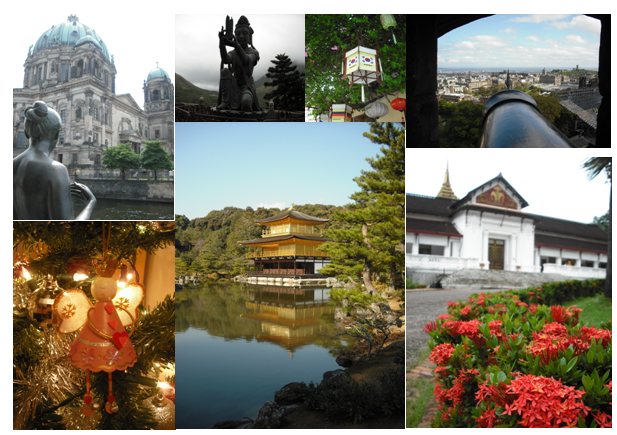
“We are tough on slogans, tough on the causes of slogans.” As said by Bill Bailey in his Part Troll stand-up routine when discussing how to describe Britain to foreigners. “Oh and we have nectar points.”
I realise that with all my entries about the kids and my apartment woes I have neglected to write about one of the subjects closest to my heart-travel. I really should blog about the amazing places in South Korea that I have been to so far. But I also wanted to introduce you to the fascinating world of city slogans in “Korea Sparkling!”
The slogan for Seoul is “Hi Seoul, Soul of Asia.” Apparently the logic behind it is thus:
The name combines the greeting "Hi" with the name of the city "Seoul,” and the new brand aims to convey a friendly image of Seoul to the global community, and to promote harmony and unity among Seoul citizens. (That’s a lot of pressure to put on a greeting and a place name!) Since "hi" is a homophone of "high,” the brand offers a new vision for Seoul and reflects the city's commitment to make Seoul one of the world's leading cities.
At least once a month I go to Seoul, the nation’s capital city, and whilst the concrete jungle has its highlights I definitely wouldn’t call it the “Soul of Asia.” That would be a lot like calling “Oxford the hugs and kisses of Europe” because of the O (hug) and the X (kiss). The only time I would ever feel warm and fuzzy in Oxford would be if I was dressed in a bear costume.
With a population of over 10 million Seoul is one of the largest cities in the world. The city is considered one of the financial and cultural centres of East Asia, but I think the self proclaimed title the “Soul of Asia” may be stretching things just a little bit. While I appreciate and enjoy the combination of both the modern and the traditional that Seoul offers, I would be wary of claiming any city the Soul of Asia, or even narrowing it down-“Soul of East Asia” or “Soul of Korea.” Fair enough, for centuries Korea has been caught between its two big brothers-Japan and China, and now wants to step out of the shadows and onto the world stage. But it’s not going to achieve that through crappy slogans.
One of my pet peeves of big cities is the amount of travelling time spent on the tube. When it feels like half your day is spent underground and you have to climb the stairs to street level eyes squinting at the sun like a mole, it’s not the nicest welcome to a new place. The Metro in Seoul is everything you want from an underground transport system, it’s clean, efficient and easy to use once you figure out where you need to go. Mobile phones here are incredible-you can plan your route on it and get the shortest route and time it will take-all without going on the internet. Annoyingly they can also be used on the underground, but that generally only a problem when an old lady’s phone is ringing and she realises she’s never seen a mobile phone before. Getting from place to place in Seoul cheaply does require spending a couple of hours a day underground. Admittedly, sat in a carriage surrounded by Koreans does allow you to make some acute observations of Korean underground etiquette, from the pushing and shoving by those getting on as you try to get off, to obsession with gadgets with large numbers of people watching the TV on their phone.
Despite this, once you arrive at your destination generally you will find something beautiful or interesting in Seoul, so it is worth the hassle. On my first visit to Seoul Rachel and Paul took me to Seoul Grand Park home of the zoo, which is surrounded by mountains and greenery, just on the outskirts of the city. Even from the centre of Seoul, you are only around an hour away from the true beauty of the Korean countryside and lion cubs!

So far I have been to two of the five palaces in Seoul (Changdeokgung see above and Deoksugung see below), and they were both outstanding examples of traditional palace architecture, despite the determined and successful attempts by the Japanese to burn them down. Deoksugung also shows the influence of the West on some of its architecture and it is right in the centre of Seoul, so you can see the modern skyscrapers dwarfing but not overshadowing the traditional.

Shopping wise there is so much choice, from the multitude of bargains at Dongdaemun, to some of the brand names at I’Park (Yongsan Station) and COEX Mall, to the market on the streets of Insadong. When you get hungry there are infinite restaurants and street vendors selling delicious food, though largely you take your pick from Korean food or……Korean food. In Itaewon there is a great Indian buffet…sooo good (drool! Thanks Viro for introducing me to this fabulous place!). The Seoul nightlife I have experienced so far is limited to Gangnam and Hongdae but both areas had a lot to offer, not least for the synchronised hip-hop dancing. Plus once you get tired of clubbing, you can always play a game of pool or 5 in a cheap billiards/pocket ball joint.
South Korea has so much to offer, and isn’t a typical tourist attraction for Westerners. While I don’t think Seoul will ever be the “Soul of Asia” it is definitely worth a visit or two or three.




No comments:
Post a Comment